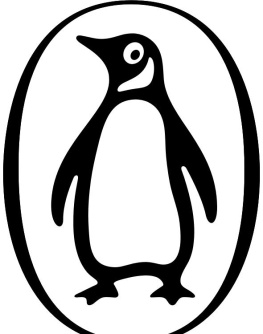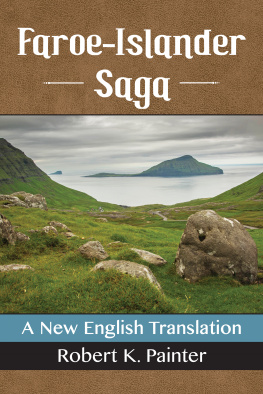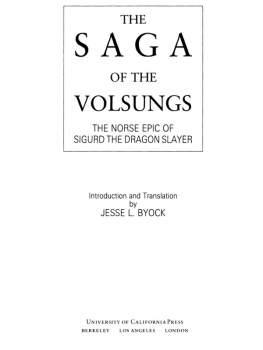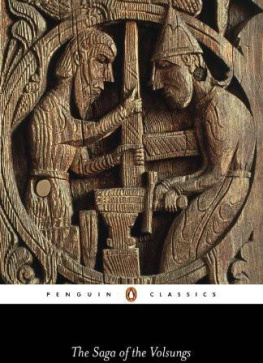The saga, whose roots reach deep into the oral culture of the ancient North, recounts the loving and warring of tribal kings and great heroes. Attila the Hun, Valkyries (warrior women of power and anger), and the war god Odin all play major roles. Woven into the medieval narrative is invaluable information concerning early beliefs, including the magical treasure of the Rhine, stories of giants, gods, and creatures. The tale of the hero Sigurd and his family the Volsungs was hugely popular in the Viking world, and the Icelandic saga is related to the medieval German poem the Nibelungenlied. Richard Wagner based much of his Ring of the Nibelung on The Saga of the Volsungs. The Introduction to this edition will open up the world of the sagas to the expert and non-expert alike.
JESSE L. BYOCK is Professor of Old Norse and Medieval Scandinavian at the University of California, Los Angeles, and a member of the UCLAs Cotsen Institute of Archaeology. He has published numerous articles and books on Iceland and the sagas, including Medieval Iceland: Society, Sagas and Power, Feud in the Icelandic Saga, Viking Age Iceland (Penguin, 2001) and a translation of The Saga of King Hrolf Kraki, also published in Penguin Classics. Professor Byock received his Ph.D. from Harvard University after studying in Iceland, Sweden and France. A specialist in North Atlantic and Viking studies, his work has been supported by grants from the National Endowment for the Humanities, the Fulbright Foundation, the National Science Foundation and the John Simon Guggenheim Foundation.
THE SAGA OF THE VOLSUNGS
The Norse Epic of Sigurd the Dragon Slayer
Translated with an Introduction, Notes and Glossary by
JESSE L. BYOCK
PENGUIN BOOKS
PENGUIN BOOKS
Published by the Penguin Group
Penguin Books Ltd, 80 Strand, London WC2R 0RL, England
Penguin Putnam Inc., 375 Hudson Street, New York, New York 10014, USA
Penguin Books Australia Ltd, 250 Camberwell Road, Camberwell, Victoria 3124, Australia
Penguin Books Canada Ltd, 10 Alcorn Avenue, Toronto, Ontario, Canada M4V 3B2
Penguin Books India (P) Ltd, 11 Community Centre, Panchsheel Park, New Delhi 110 017, India
Penguin Books (NZ) Ltd, Cnr Rosedale and Airborne Roads, Albany, Auckland, New Zealand
Penguin Books (South Africa) (Pty) Ltd, 24 Sturdee Avenue, Rosebank 2196, South Africa
Penguin Books Ltd, Registered Offices: 80 Strand, London WC2R 0RL, England
www.penguin.com
This edition first published in the USA by the University of California Press 1990
First published in Great Britain in Penguin Classics 1999
17
Copyright the Regents of the University of California, 1990
All rights reserved
The moral right of the translator has been asserted
Except in the United States of America, this book is sold subject to the condition that it shall not, by way of trade or otherwise, be lent, re-sold, hired out, or otherwise circulated without the publishers prior consent in any form of binding or cover other than that in which it is published and without a similar condition including this condition being imposed on the subsequent purchaser
ISBN: 978-0-14-192155-6
To my daughter Ashley and the fun we had telling the Sigurd story on a trout fishing trip
CONTENTS
MAPS
INTRODUCTION
The unknown Icelandic author who wrote The Saga of the Volsungs in the thirteenth century based his prose epic on stories found in far older Norse poetry. His sources, which may have included a lost earlier prose saga, were rich in traditional lore. The Saga of the Volsungs recounts runic knowledge, princely jealousies, betrayals, unrequited love, the vengeance of a barbarian queen, greedy schemes of Attila the Hun, and the mythic deeds of the dragon slayer, Sigurd the Volsung. It describes events from the ancient wars among the kings of the Burgundians, Huns, and Goths, treating some of the same legends as the Middle High German epic poem, the Nibelungenlied. In both accounts, though in different ways, Sigurd (Siegfried in the German tradition) acquires the Rhinegold and then becomes tragically entangled in a love triangle involving a supernatural woman. In the Norse tradition she is a valkyrie, one of Odins warrior-maidens.
In Scandinavia, during the centuries after the Middle Ages, knowledge of the Sigurd story never died out among the rural population. Full of supernatural elements, including the schemes of one-eyed Odin, a ring of power, and the sword that was reforged, the tale was kept alive in oral tradition. In the nineteenth century, as the Volsung story was discovered by the growing urban readership, it became widely known throughout Europe. Translated into many languages, it became a primary source for writers of fantasy, and for those interested in oral legends of historical events and the mythic past of northern Europe. The saga deeply influenced William Morris in the nineteenth century and J. R. R. Tolkien in the twentieth. Richard Wagner, in particular, drew heavily upon the Norse Volsung material in composing the Ring cycle. In 1851 he wrote to a friend concerning the saga:
Already in Dresden I had all imaginable trouble buying a book that no longer was to be found in any of the book shops. At last I found it in the Royal Library. It is called the Vlsunga sagatranslated from Old Norse by H. von der Hagen [1815]. This book I now need for repeated perusal. I want to have the saga again; not in order to imitate it, rather, to recall once again exactly every element that I already previously had conceived from its particular features. [Wagners use of the Volsung material is discussed later in this Introduction.]
One can only speculate about the origin of the sagas dragon slaying and of other mythic events described in the tale. Many of the sagas historical episodes, however, may be traced to actual events that took place in the fourth and fifth centuries A.D., the period of great folk migrations in Europe. In this time of upheaval, the northern frontier defenses of the Roman Empire collapsed under the pressure of barbarian peoples, as Germanic tribes from northern and central Europe and Hunnish horsemen from Asia invaded what is now France and Germany. A seemingly endless series of skirmishes and wars were fought as tribes attempted to subjugate their enemies and to consolidate newly won territories into kingdoms and empires.
The memory of the migrations became part of the oral heritage of the tribesmen, as epic poems about heroes and their feats spread throughout the continent during succeeding centuries. In the far north legends and songs about Burgundians, Huns, and Goths, as well as new or revised stories about indigenous northern families such as the Volsungs, became an integral part of the cultural lore of Scandinavian societies. The old tales had not died out by the Viking Age (ca. 8001070), that is, several centuries after the migration period had ended. On the contrary, during this new age of movement in Scandinavia the epic cycles of the earlier migration period seem to have gained in popularity. As Norsemen sailed out from Viking Scandinavia in search of plunder, trade, and land, they carried with them tales of Sigurd and the Volsungs.


